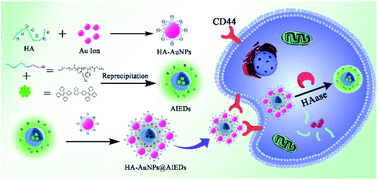Rational design of a HA-AuNPs@AIED nanoassembly for activatable fluorescence detection of HAase and imaging in tumor cells†
Abstract
Aggregation induced emission (AIE) dots have gained broad attention in fluorescence bioimaging and biosensors in virtue of their distinctive optical properties of splendid biocompatibility, high brightness and good photostability. However, the application of AIE dots in sensing and imaging of enzymes in cells remains at an early stage and needs to be further explored. In this report, we proposed a novel AIE-dot-based nanoprobe for hyaluronidase (HAase) detection using a simple electrostatic self-assembly of AIE dots with gold nanoparticles functionalized using hyaluronic acid (HA-AuNPs), named HA-AuNPs@AIEDs. The fluorescence of AIE dots can be obviously quenched by HA-AuNPs via fluorescence resonance energy transfer (FRET). HAase could degrade HA into small pieces and thus induce disassembly of AuNPs and AIEDs, accompanied by fluorescence recovery of AIEDs. The as-prepared nanoprobe exhibited high sensitivity, excellent selectivity, wide response range and desirable anti-interference for quantitative sensing of HAase in vitro. The detection limit was down to 0.0072 U mL−1. Moreover, the nanoprobe displayed good biocompatibility and excellent photostability, and thus offered a practicable “turn-on” strategy for specific, high-contrast fluorescence imaging of HAase in live tumor cells. The AIE-based nanoprobe may provide a novel universal platform for recognition and imaging of HAase in tumors, and may be beneficial for related biological research.



 Please wait while we load your content...
Please wait while we load your content...